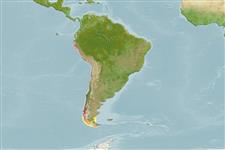Common names from other countries
Environment: milieu / climate zone / depth range / distribution range
Écologie
; profondeur 0 - 40 m (Ref. 87801). Temperate, preferred 12°C (Ref. 107945); 6°S - 56°S, 81°W - 66°W (Ref. 111805)
Eastern Pacific and Western Atlantic: From Lobos de Afuera Island, Peru to Cape Horn, Chile.
Length at first maturity / Taille / Poids / Âge
Maturity: Lm ? range ? - ? cm Max length : 15.0 cm ShL mâle / non sexé; (Ref. 356)
Life cycle and mating behavior
Maturité | Reproduction | Frai | Œufs | Fécondité | Larves
Egg masses are composed of 243 to 256 egg capsules, each capsule containing 668 to 14,250 eggs. The capsules are found attached to a substrate by a stalk. Larva emerges from the egg and remains in the water column for a long period of time before settling (Ref. 87801).
Häussermann, V. and G. Försterra. 2009. (Ref. 87801)
Statut dans la liste rouge de l'IUCN (Ref. 130435: Version 2024-1)
statut CITES (Ref. 108899)
Not Evaluated
Not Evaluated
Utilisations par l'homme
Pêcheries: commercial
FAO - Aquaculture: production; pêcheries: landings | FishSource | Sea Around Us
Outils
Sources Internet
Estimates based on models
Résilience
Très faible, temps minimum de doublement de population supérieur à 14 ans (K=0.06).
Vulnérabilité
Low to moderate vulnerability (31 of 100).
